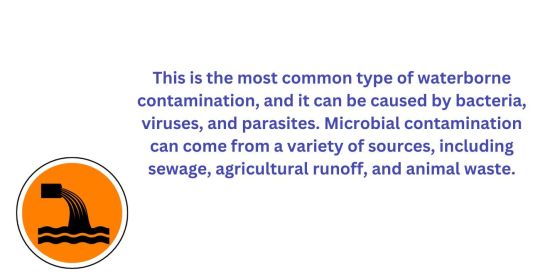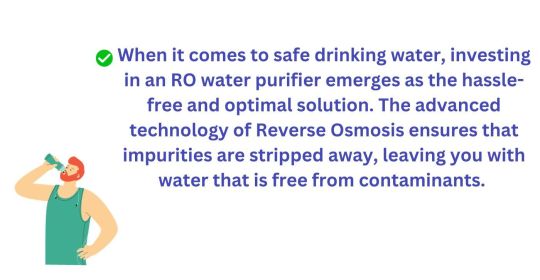#RO Water Purifier for Drinking
Text
aquaquot is a WATER PURIFIER related SERVICES provider in Bangalore.
water purifier on lease, water purifier repairs, water purifier services, buy water purifier and accessories at affordable price.
2 notes
·
View notes
Text
The Importance of Commercial Water Purifiers: A Guide to Clean Water Solutions for Businesses
Water is the backbone of every business, and ensuring its purity is essential for industries ranging from food and beverage to pharmaceuticals. In today’s world, where water contamination is a growing concern, having a reliable commercial water purifier is no longer optional—it’s a necessity.
Why Commercial RO Water Purifiers Matter
Commercial RO (Reverse Osmosis) water purifiers offer a robust solution for businesses needing to maintain high water quality standards. By removing harmful contaminants, dissolved salts, and chemicals, these systems provide clean, safe water critical for industrial processes. This ensures compliance with regulatory standards like HACCP, cGMP, and FSSAI, particularly in industries where water quality directly impacts product safety.
Industries that Benefit from RO Systems
Food & Beverage: Ensures product quality and customer safety by providing clean water for production and processing.
Pharmaceuticals: Guarantees the purity of water used in drug manufacturing, a critical factor for compliance.
Healthcare: Delivers safe, contaminant-free water for hospital and clinical use.
Choosing the Right Water Purification System
When selecting a commercial water purifier, businesses should consider capacity, water quality needs, and maintenance requirements. If you're in search of a solution that ensures consistent water quality, Alfaa UV’s commercial RO water purifiers are designed to meet the demands of any industry.
For more information on how our Commercial RO Water Purifiers can enhance your business operations, visit our website today.
#water purifier#water purification#ro water purifier#health & fitness#uv water purifier#water purifiers#pure water#drinking water
0 notes
Text
Under The Sink Reverse Osmosis (uts-RO) systems offer several advantages for your kitchen and home:
1. Cleaner, healthier drinking water: RO filtration removes a wide range of contaminants like chlorine, lead, bacteria, and even some pesticides, providing peace of mind that your water is safe to drink.
2. Improved taste and odor: By eliminating impurities, RO systems significantly improve the taste and odor of your water. You might even notice a difference in how your coffee or tea brewed with filtered water tastes.
3. Convenience and space-saving: Unlike pitcher filters that require refilling, under-sink RO systems have a dedicated faucet and a storage tank. This means you can access clean, filtered water whenever you want, without taking up counter space.
4. Potentially better for some appliances: RO water can be helpful for appliances like steamers and irons, as it can minimize mineral build-up.
5. Reduced plastic waste: By eliminating the need to buy bottled water, RO systems can help you reduce your environmental impact.
Visit Dhwaneer's website to get best Pentair uts-RO systems in India.
#water filter for home#water filters#pentair#ro system#under sink#Trendy RO#best water softener#water softener system#sales#water filtration#water purifier#drinking water
0 notes
Text

All of us do know some general benefits of having a water purifier in our home as every human being requires access to clean and safe drinking water.
If you want to purchase a water filter for home, the sheer quantity of brands and types available on the market can be overwhelming. Because there are so many different types of water purifiers, you'll need to know a few things before you can start narrowing down your options. So we have summed up an easy water purifier buying infographic by Shri Shivaay Industries to help you pick the best purifier for your home.
#shri shivay industries#water purifier#ro water purifier#drinking water#Water ionizer#water ionizer machine#ionizers#purifiers#fences#lockers#safes#water filter#safe drinking water
1 note
·
View note
Text

Drinking impure water has harmful effects on your health, as it acts like a slow poison, causing routine illness like Cholera, Dysentery, Diarrhea, Jaundice, Tuberculosis and even diseases like Cancer. More than 37.7 million Indians are affected by water borne diseases annually, with over 1.5 million children are estimated to die of Diarrhea alone. More than 80% of stomach diseases in India are caused by polluted water
#Drinking impure#polluted water#Chemicals in River Water:#KENT RO#Zero Water Wastage#Zero Water Wastage Technology#Water Purifier
0 notes
Text
Impact of Poor Water Quality on Health
Did you know that drinking water is the most important thing you can do for your health?
But what if you’re drinking the wrong kind of water?
Poor water quality can have a devastating impact on your health, causing a wide range of illnesses, including diarrhea, cholera, and typhoid.
Even today only 2% of Indians get safe drinking water in their taps, according to a survey conducted. Not to mention, 37.7 million Indians are affected by severe waterborne illnesses every year.
Shocking isn’t it?
If you are wondering how I can drink 100% clean water, you have come to the right place! In this blog post, we will discuss the impact of poor water quality on health in more detail. We will also discuss why it is important to be careful about the water you drink and how you can protect yourself from waterborne diseases.
Let’s dive in!
Understanding the different causes of poor water quality

Here are some of the reasons for poor water quality in your households:
Microbial contamination
This is the most common type of waterborne contamination, and it can be caused by bacteria, viruses, and parasites. Microbial contamination can come from a variety of sources, including sewage, agricultural runoff, and animal waste.
Chemical contamination
This can be caused by a variety of chemicals, including industrial pollutants, pesticides, and fertilizers. Chemical contamination can also come from natural sources, such as arsenic and uranium.
Physical contamination
This can be caused by sediment, debris, and other physical contaminants. Physical contamination can come from a variety of sources, including erosion, flooding, and construction.
Infrastructure failure
This can happen when water treatment facilities or distribution systems fail. Infrastructure failure can be caused by a variety of factors, including aging infrastructure, natural disasters, and budget cuts.
Other reasons for poor water quality include sewage leaks, agricultural waste, industrial pollution, and natural disasters.
It is important to note that poor water quality can be caused by a combination of factors. For example, a sewage leak could contaminate a water source, and then a failure in the water treatment system could allow the contaminated water to be distributed to consumers.
What is the impact of poor water quality on our health?
Drinking poor-quality water poses significant health risks, with consequences ranging from acute to chronic ailments.
Gastric disorders
Contaminants such as bacteria, viruses, and parasites in untreated water can lead to severe gastrointestinal issues, causing symptoms like diarrhea, nausea, and stomach cramps. Waterborne diseases, including cholera and dysentery, thrive in unsanitary conditions, jeopardizing the well-being of individuals exposed to contaminated water sources.
Related Reading: Common Water Contaminants and How Purifiers Remove them
Developmental problems
Moreover, long-term water consumption containing heavy metals like lead and arsenic has been linked to chronic health problems. Prolonged exposure to elevated levels of these metals may result in developmental issues in children, damage to the nervous system, and an increased risk of various cancers. Poor-quality water is also a breeding ground for harmful toxins and pollutants, further compromising public health.
Waterborne illnesses
Communities lacking access to clean water face a higher incidence of waterborne illnesses, perpetuating a cycle of poverty and ill health. Inadequate sanitation and water treatment infrastructure exacerbate these issues, particularly in developing regions where resources are limited.
Addressing the health issues caused by poor-quality drinking water requires a multi-faceted approach, involving improved water treatment, enhanced sanitation practices, and public awareness campaigns. Ensuring access to safe and clean water is essential for safeguarding the health and well-being of communities worldwide.
How to improve the poor water quality
1. Stop using plastic water bottles
Transform your home into a plastic-free haven for drinking water. Bid adieu to plastic bottles, notorious for contamination risks and microplastic leaching. Choose reusable, eco-friendly alternatives that contribute to a greener planet and ensure every sip is free from harmful residues.
2. Skip the Water Cans
Stop depending on water cans for your daily drinking water needs. Often they are stored out in the sun for long periods and exposed to harmful UV rays, dirt, and rain. These UV rays can break down the plastic water cans into microplastics which end up leaching into your drinking water. Opting for water cans means you are putting yourself at risk of suffering from water and microplastic contamination.
3. Invest in RO-Based Water Purification
Revolutionize your hydration routine by investing in a reputed RO water purifier. This powerhouse technology ensures your drinking water is free of impurities, ensuring clean, safe, and healthy drinking water for your daily hydration needs.
4. Regular maintenance of water purifiers
This is an important step many people overlook. Regularly clean and maintain your RO water purifier, addressing not just the water filtration component but also the overall system. Conduct a thorough check at least once a year to guarantee optimal performance.
5. Constant Water Quality Monitoring
It is important to monitor water quality due to its fluctuating nature. When you choose DrinkPrime, we make sure we always monitor your water quality 24×7 to analyze any changes in TDS or pH levels and other water quality parameters. We prioritize your health by keeping a vigilant eye on your water quality, delivering perfectly purified drinking water every time.
Embracing these practices at your home will ensure each drop is 100% clean and safe to drink! By doing these you no longer have to worry about poor water quality ever.
Conclusion

When it comes to safe drinking water, investing in an RO water purifier emerges as the hassle-free and optimal solution. The advanced technology of Reverse Osmosis ensures that impurities are stripped away, leaving you with water that is free from contaminants.
What adds an extra layer of convenience to this solution is the option to consider renting a water purifier. Opting to get a water purifier on rent not only reduces the heavy upfront cost of buying a water purifier but also ensures that you have access to the latest purification technology without the worry of maintenance and other expenses. It’s a seamless and cost-effective approach that lets you enjoy the benefits of a top-notch RO water purifier without the headaches of ownership.
Source: Impact of Poor Water Quality on Health
#water purifier on rent#ro water purifier#drinkprime water purifier#drinkprime water purifier on rent#benefits of drinking water#water purifier for home#water purifier on rent in bangalore
0 notes
Text
Iron removal water treatment plant, iron water removal plant.
How Iron Treatment Systems Work.
Iron treatment systems work by removing iron particles from water through various processes, including filtration, oxidation, and ion exchange. Here's a closer look at how each type of system works:
1 Water Softeners: Water softeners use a process called ion exchange to remove iron particles from water. The water flows through a tank filled with resin beads that attract and remove the iron particles.
When the resin beads become saturated with iron, they are regenerated using salt water, which washes away the iron particles and restores the resin's ability to attract more iron.
2 Greensand Filters: Greensand filters use a material called greensand to remove iron from water. The greensand is typically housed in a tank, and the water flows through the tank, allowing the
greensand to remove the iron particles.
3 Reverse Osmosis: Reverse osmosis systems use a semipermeable membrane to remove impurities from water, including iron particles. The water flows through the membrane, leaving behind impurities and producing purified water.
Conclusion
Iron treatment systems are an effective solution for removing iron from water and improving its quality.
The type of system you choose will depend on your specific needs and preferences, as well as the level of
iron in your water. By understanding how these systems work, you can make an informed decision about which one
is right for you. With the right iron treatment system, you can enjoy clean, high-quality water.
Iron removal water treatment plant
iron water removal plant
Water Iron Removal Plant in Kerala

#best water purifier#filtration in water treatment#water filtration#ro water filter#home water filter#water solutions#water ro#water purifier plant#drinking water treatment#iron filter
0 notes
Text
Get Aqua Best RO Water Purifier WaterFilter Dubai - Sharjah Ajman Abudhabi Alain UAE
Domestic RO water filter supplier in UAE, get more information on our domestic water filters and water purifiers, services available in Emirates UAE.Aqua best is the best Commercial & Industrial RO system, Water filtration, water purifier, Water Softener, Industrial Water Filtration System in the DubaiContact Us +971529920566, 042851510

#ro system#water filter#water treatment plant#water purifier#drinking water#water treatment system#Water
0 notes
Link
0 notes
Text
🌊 So what's the deal with Mizorogi Hokuto and the Omizu-sama religion?

"Does the water taste delicious?"
Based on my theory that the names in Mononoke Karakasa have metaphorical meanings which may predict their respective plotlines and motivations, Let's break down his Mizorogi's full name character by character.
⭐️北斗(Hokuto) - The Big Dipper
In Japanese culture, the Big Dipper, a.k.a. Ursa Major has two major deities:
妙見 (Myōken) - A Buddhist deity and guardian of horses. Heals eyes diseased. Considered by many to be a bodhisattva because of his compassion, yet is depicted as a sword-bearing warrior.
天之御中主 (Ame-no-Minakanushi) - A Shinto deity. The first, or one of the first deities that manifested when heaven and earth came into existence.
The lore drop of the hexagram paradigm introduces the medicine seller headquarters –Jyu-Shoku– existing between the human realm (earth) and Shuuga –the collected/search for self– which exists both everywhere and nowhere (heavens). So I'm pretty sure Shinto deity is the namesake of this water priest character.
🚰溝 (Mizo) - Ditch/Gutter/Trench
Interesting - so the theme of controlling the flow of water is already embedded into his name.
📣呂(Ro) - Bass Range of Japanese Instruments
This is a bit of a stretch, but would the sound of rainfall forming ripples upon the surface of water be considered musical? Or perhaps the interpretation here is that water ripples when a bass note rumbles through it. Basically, the baritone sound of his sermons controlling the women's desires, symbolized by water.
🪣木(Gi/Ki) - Wood
According to 五行 (Go-Gyo), the relationship between the five primordial elements, wood is nourished by water. Another interpretation: wood depletes water. Coincidentally, the buckets that draw water from the well, as well as the laquered triangular bowls which the women drink the well water from, are made of wood.
🧩Putting it all together, I believe Hokuto Mizorogi of the Omizu-sama religion is driven to do the following:
🌧️ Control the women of the ooku, whose "impure" desires are symbolized by natural rainfall

☔️ Shield the women from their "impure" desires with umbrellas (The waterproof repelling qualities are worn off with repeated usage, creating perfect breeding grounds for the Karakasa)

🚰 Diverting the women's desires (gutters/trenches) into the stone well.

📣 Reciting his sermons (bass tone of his voice manipulating water into artificially rippling) to manipulate the women's desires to align with the ooku's needs.

🪣 Having the women drink the purified well water regimented by buckets and cups (wood).

⭐️And this is all in service to a star-touched deity that was firstborn at the manifestation of the heavens and earth - who Tenshi, the shogun, represents.

Stay tuned for my thoughts on his Mizorogi's twin daughters!
#mononoke 2024#mononoke karakasa#モノノ怪#hokuto mizorogi#mizorogi hokuto#北斗溝呂木#analysis#purplealmonds#2024#🔕
32 notes
·
View notes
Text

#drinking water#water purifier#air purifier#hydrogen rich water#ro repair#mineral water#water purification#best water filtration system for home#best water purifier#water purifier on lease
0 notes
Text

Get Top-Quality Aquaguard RO Water Purifiers in Bhopal | Ramji Enterprises
Looking for the best RO water purifiers in Bhopal? Ramji Enterprises offers premium Aquaguard RO water purifiers to ensure clean and safe drinking water for your family. With our wide range of products and excellent customer service, we are committed to delivering top-notch water purification solutions tailored to your needs. Visit our website or contact us at +91-9827018625 to explore our latest offerings and bring home the assurance of pure water today!
2 notes
·
View notes
Text
"Discovering the Best Water Purifiers in Bangladesh with eshop.co.bd"
In the quest for clean and safe drinking water, eshop.co.bd has become the go-to online store in Bangladesh, offering a variety of top-notch water purifiers. Let's explore some popular brands available on eshop.co.bd, including Livpure, Havells, Ao Smith, Kent, Pureit, and Drinkcan.
1. Water Purifier in Bangladesh:
The increasing awareness about water quality has made water purifiers a household essential in Bangladesh. Eshop.com.bd stands out as a reliable platform, ensuring access to quality water purifiers to meet diverse needs.
2. Livpure Water Purifier:
Livpure, known for its innovative technology, is a prominent brand in the water purification sector. eshop.co.bd proudly features Livpure water purifiers equipped with advanced RO, UV, and UF filtration technologies for clean and healthy drinking water.
3. Havells Water Purifier:
Combining style with functionality, Havells water purifiers are a popular choice. eshop.co.bd showcases a diverse collection of Havells purifiers featuring cutting-edge RO and UV technologies to ensure the delivery of safe and clean drinking water.
4. Ao Smith Water Purifier:
Global brand Aosmith is recognized for high-performance water purification systems. eshop.co.bd includes Ao Smith water purifiers in its inventory, providing consumers with access to state-of-the-art technology for effective removal of impurities.
5. Kent Water Purifier:
Kent, a household name in water purifiers, is known for superior RO purification technology. eshop.co.bd offers a range of Kent water purifiers designed to eliminate harmful contaminants and provide households with top-tier water purification solutions.
6. Pureit Water Filter:
Pureit, under Hindustan Unilever, is synonymous with reliability. Eshop.co.bd features Pureit water filters with advanced purification mechanisms to meet stringent quality standards and ensure clean and safe drinking water.
7. Drinkcan Water Purifier:
As a rising star in water purification, Drinkcan offers innovative solutions. Eshop.co.bd ensures customers have access to Drinkcan water purifiers designed to cater to diverse needs and provide clean and safe drinking water.
Conclusion:
Eshop.co.bd emerges as a trusted destination for quality water purifiers in Bangladesh. With a curated selection of popular brands, including Livpure, Havells, Ao Smith, Kent, Pureit, and Drinkcan, the online store plays a vital role in meeting the demand for reliable water purification solutions, ensuring households have access to clean and safe drinking water.
2 notes
·
View notes
Text
How to Choose the Best RO Plant for Residential and Industrial Use: A Comprehensive Guide

Introduction:
Water is an essential resource for all living beings, and access to clean and safe drinking water is a necessity. Reverse Osmosis (RO) plants have become a popular choice for water purification in both residential and industrial settings due to their effective filtration process. However, with a plethora of options available, selecting the right RO plant can be a daunting task. In this blog, we will provide a comprehensive guide to help you make an informed decision when choosing the best RO plant for residential and industrial purposes. Additionally, we'll introduce Go On Sales Corporation, a leading water treatment company known for providing top-notch water solutions.
Understanding RO Water Purification:
Before we delve into the selection process, let's briefly understand how RO water purification works. In an RO plant, water is passed through a semi-permeable membrane that blocks impurities and contaminants, leaving behind clean and pure water fit for consumption.
Choosing the Best RO Plant for Residential Use:
Assessing Water Quality:
Conduct a water test to determine the quality of your water source and identify specific contaminants.
Understand the TDS (Total Dissolved Solids) level and other impurities present in the water.
Capacity and Flow Rate:
Evaluate your household's daily water consumption to determine the ideal capacity and flow rate required.
Ensure the chosen RO plant can meet your family's water needs efficiently without any interruptions.
Number of Stages:
Consider an RO plant with multiple stages of purification for enhanced filtration.
Evaluate your budget and choose the number of stages based on your water quality requirements.
Membrane Quality:
The RO membrane is the heart of the plant. Opt for a high-quality membrane that effectively removes impurities while maintaining good water flow.
Storage Tank:
Check the capacity of the storage tank to ensure a continuous supply of purified water, especially during power outages.
TDS Controller:
Consider an RO plant equipped with a TDS controller to retain essential minerals in the water for healthier consumption.
Energy Efficiency:
Choose an energy-efficient RO plant to minimize electricity consumption and save on utility bills.
Choosing the Best RO Plant for Industrial Use:
Water Analysis:
Conduct a comprehensive water analysis to identify the specific contaminants and treatment requirements for your industrial processes.
Customization:
Select an RO plant provider that offers customization to cater to your industry's unique water purification needs.
System Capacity:
Determine the required system capacity based on your industrial water demand and peak consumption periods.
Pre-treatment:
Some industrial water sources may require pre-treatment to remove specific contaminants or adjust pH levels. Choose an RO plant equipped with appropriate pre-treatment modules.
Automation and Monitoring:
Opt for an RO plant with advanced automation and monitoring capabilities for efficient operation and easy maintenance.
Durability and Maintenance:
Consider the durability and ease of maintenance of the RO plant, as industrial environments may put the system through heavy usage.
When it comes to choosing the best water treatment company, Go On Sales Corporation stands out as a reliable and leading provider of water solutions. With a strong commitment to quality and customer satisfaction, they offer a wide range of water treatment products, including RO plants for both residential and industrial applications.
Reasons to Choose Go On Sales Corporation:
Expertise and Experience:
With years of experience in the water treatment industry, Go On Sales Corporation has the expertise to deliver top-quality solutions.
Customized Solutions:
They understand that each customer's water needs are unique and offer tailor-made solutions to meet specific requirements.
High-Quality Products:
Go On Sales Corporation ensures that their RO plants are equipped with the latest technology and top-notch components for optimum performance.
Excellent Customer Support:
Their dedicated customer support team is always ready to assist with any queries or concerns, providing prompt and efficient service.
Trust and Reliability:
As a trusted water treatment company, they have earned a reputation for reliability and delivering on promises.
Conclusion:
Selecting the best RO plant for residential and industrial purposes involves careful consideration of water quality, capacity, stages, membrane quality, energy efficiency, and other specific requirements. By understanding your unique needs and conducting thorough research, you can make an informed decision that ensures access to clean and safe drinking water for your family or business. Furthermore, with Go On Sales Corporation as your water treatment company, you can rest assured of receiving top-quality products and excellent customer support. Choose wisely and experience the benefits of an efficient and reliable RO plant from Go On Sales Corporation.
2 notes
·
View notes
Text
How to Remove Fluoride from Drinking Water?
Fluoride and drinking water- sounds a bit strange, doesn’t it?
But what if we tell you your drinking water has fluoride as well? No, we are not kidding!
It is often added to your tap water in order to improve your overall oral health without doing anything additional.
If you’ve seen any of those toothpaste ads, you’ve likely heard a thing or two about fluoride. It is a mineral found in nature – in water, soil, and some foods. It is also added to some toothpaste, mouthwash, and other dental products. Fluoride is important for dental health because it helps to strengthen teeth and make them more resistant to decay.
However, it is important to note that drinking water filled with excess amounts of fluoride is not good for you in the long run. It not only has the potential to cause dental fluorosis but also other health problems like nausea and diarrhea as well.
In this blog post, we will discuss why fluoride is added to your drinking water, why too much fluoride is not good for you, and how to remove fluoride from drinking water.
So sit back, relax, and let’s dive in!
Why is fluoride added to your drinking water?
Before we understand how to remove fluoride from drinking water, let’s understand what fluoride is. Just like what we talked about above, Fluoride is a naturally occurring mineral that has been shown to be effective in preventing tooth decay. It is added to drinking water in many communities around the world to help people maintain good oral health.
There are two main reasons why fluoride is added to water:
1. To prevent tooth decay
Fluoride works by making teeth more resistant to the acids produced by bacteria in the mouth. These acids can break down tooth enamel and lead to cavities. Fluoride also helps to repair early signs of tooth decay.
2. To strengthen your pearly whites
Fluoride helps to strengthen tooth enamel, making teeth less likely to chip or crack. The safe level of fluoride in drinking water varies depending on the age of the person and the climate. The World Health Organization recommends a fluoride concentration of 0.5 to 1.0 milligrams per liter (mg/L) for adults and children over the age of 8.
Let’s have a look at some of the problems caused by large amounts of fluoride and why it is important for everyone to know how to remove fluoride from drinking water.
What are the health problems caused by fluoride in drinking water?
Excessive fluoride in drinking water has the potential to cause various health issues, giving rise to a range of side effects:

1. Dental Fluorosis
One of the most common consequences of high fluoride levels is dental fluorosis. This condition manifests as discoloration and pitting of tooth enamel, impacting dental aesthetics and, in severe cases, functionality.
2. Skeletal Fluorosis
Prolonged exposure to high fluoride concentrations in drinking water can affect bone health, leading to skeletal fluorosis. Symptoms include joint pain, stiffness, and impaired mobility, reflecting the adverse impact on the skeletal system.
3. Neurological Concerns
Studies have explored a potential link between increased fluoride intake and adverse effects on cognitive function. While not conclusively proven, these findings raise concerns about neurological health in areas with high amounts of fluoride in drinking water.
This is why one needs to learn how to remove fluoride from drinking water. It is better to be careful of the fluoride levels in drinking water to prevent these adverse health effects. A delicate balance is required to get fluoride’s positive benefits on dental health while eliminating potential risks to our health.
GET 7-DAYS RISK-FREE TRIAL
How to remove fluoride from drinking water?
If you’re concerned about how to remove fluoride from drinking water and seek methods for removal, here’s a comprehensive guide on how to achieve pure and fluoride-free drinking water.
1. Reverse Osmosis (RO)

Among various methods, Reverse Osmosis (RO) stands out as one of the most effective ways to remove fluoride from your water. RO systems use a semi-permeable membrane to filter out impurities, including fluoride ions. The process ensures a high removal rate, making it a reliable choice for households concerned about fluoride in their water supply. If you are researching on how to remove fluoride from drinking water, this option is the most reliable and cost-effective one
2. Bone Char Carbon Filters
Bone char carbon filters utilize a natural adsorption process to remove fluoride. Made from animal bones, these filters have a porous structure that captures fluoride ions. It’s essential to note that this method may have limitations, and filter quality can vary.
3. Distillation
Here is one method on how to remove fluoride from drinking water. Distillation involves heating water to create steam, which is then condensed back into liquid form. This method effectively eliminates fluoride, along with other contaminants, leaving you with purified water. While distillation can be energy-intensive, its thorough purification process makes it a viable option for those seeking fluoride-free water.
Related Reading: Distilled Water vs Purified Water: Pro ,Cons and Comparison
4. Activated Alumina Filters
Activated alumina is a filter media known for its ability to adsorb fluoride ions from water. These filters work by attracting and holding fluoride, reducing its concentration in the treated water. While effective, it’s crucial to replace activated alumina filters regularly to maintain their efficiency.
5. Ion Exchange Filters
Ion exchange filters replace fluoride ions with less harmful ions, effectively reducing fluoride levels. However, regular maintenance and the need for regeneration make this method more complex compared to others.
GET 7-DAYS RISK-FREE TRIAL
Conclusion
While multiple methods exist to remove fluoride from drinking water, Reverse Osmosis stands out as a reliable and efficient solution. Its high removal rate, ease of use, and minimal maintenance make RO water purifiers the best method for anyone reading up on how to remove fluoride from drinking water. Consider the specific needs of your household and the efficiency of each method when deciding on the best approach to safeguard your water quality.
With the right water purifier in place, you can enjoy peace of mind, knowing your drinking water is free from excess fluoride and other contaminants.
Source: How to Remove Fluoride from Drinking Water?
#how to remove fluoride from drinking water#fluoride in drinking water#fluoride levels in water#normal fluoride level in drinking water#how to remove fluoride from your drinking water#ro water purifier#drinkprime water purifier on rent#drinkprime water purifier#water purifier on rent#water purifier on rent in bangalore
0 notes
Text
Water Iron Removal Plant in Kerala
Iron Treatment Systems: A Guide to Removing Iron from Your Water
Iron is a common problem in many water sources, and it can cause a range of issues,from stains on clothing and dishes to foul odors and tastes in the water. Fortunately,there are iron treatment systems available that can effectively remove iron from waterand improve its quality. In this article, we'll explore the different types of iron treatment systems and how they work.
Types of Iron Treatment Systems
There are several types of iron treatment systems available, each with its own benefits and drawbacks.
Here are some of the most common systems:
1 Water Softeners: Water softeners use a process called ion exchange to remove iron and other minerals from water.The water flows through a tank filled with resin beads that attract and remove the iron particles. Water softenersare effective at removing iron, but they can also remove beneficial minerals from the water, which may affect its
taste and health benefits.
2 Oxidation Filters: Oxidation filters use a process called catalytic conversion to convert iron particles intoa solid form that can be filtered out of the water. This process typically requires the use of a chemical oxidizer,such as chlorine or hydrogen peroxide, to convert the iron. While oxidation filters are effective at removing iron,
they can also add chemicals to the water that may affect its taste and health benefits.
3 Greensand Filters: Greensand filters use a material called greensand to remove iron from water. Greensandis a natural mineral that contains manganese oxide, which can effectively remove iron particles from water.Greensand filters are effective at removing iron, but they require regular backwashing to prevent clogging.
4 Reverse Osmosis: Reverse osmosis systems use a process called membrane filtration to remove impurities from water. These systems are effective at removing iron, as well as other contaminants like lead, fluoride, and arsenic. However,reverse osmosis systems are typically more expensive and require regular maintenance.
katalox light
katalox light media
katalox filter media
water treatment systems
#water purification#water treatment systems#water filter#c#water purification plant#ro water#water treatment#best water filter#best water purifier#filtration in water treatment#water filtration#ro water filter#home water filter#water solutions#water ro#water purifier plant#drinking water treatment#iron filter
0 notes